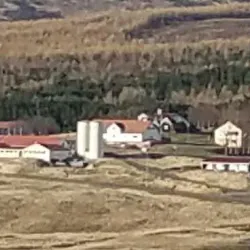Quality of life in Holar
Holar, located in the northern part of Iceland, is a small yet historically significant town known for its rich cultural heritage and educational prominence. It serves as a cultural and educational hub, with Holar University College being a key institution in the area. The town is surrounded by stunning natural landscapes, offering a serene and picturesque environment that attracts visitors seeking tranquility and a connection with nature.
In recent years, Holar has seen a growing interest in sustainable tourism and eco-friendly practices, aligning with Iceland's broader environmental goals. This trend is reflected in the local initiatives aimed at preserving the natural beauty and cultural heritage of the area, making Holar a model for sustainable living and tourism.
History and Culture
Holar's history dates back to the 11th century when it became one of Iceland's two episcopal sees, making it a significant religious and cultural center. The town played a crucial role in Iceland's ecclesiastical history, with Holar Cathedral being one of the oldest stone churches in the country. This historical significance is still evident today, as the cathedral remains a focal point for visitors and locals alike.
Throughout the centuries, Holar has been home to many notable figures, including bishops and scholars who have contributed to Iceland's cultural and educational development. The town's commitment to education is further exemplified by Holar University College, which continues to be a leading institution in fields such as aquaculture, equine studies, and tourism.
Culturally, Holar is a testament to Icelandic traditions and heritage. The town hosts various cultural events and festivals that celebrate its history and the broader Icelandic culture. These events provide a glimpse into the local customs and traditions, offering visitors a unique cultural experience.
Things to do in Holar
Visitors to Holar can explore the historic Holar Cathedral, a landmark that offers insight into the town's religious and architectural history. The cathedral's serene surroundings make it a perfect spot for reflection and appreciation of Icelandic heritage.
Holar University College offers guided tours that provide an educational experience about the region's academic contributions and research in sustainable practices. These tours are ideal for those interested in learning about the intersection of education and environmental stewardship.
Outdoor enthusiasts can enjoy the breathtaking landscapes surrounding Holar, with opportunities for hiking, horseback riding, and bird watching. The area's natural beauty is complemented by its commitment to eco-friendly tourism, ensuring that visitors can enjoy the environment responsibly.
Cultural events and festivals in Holar offer a vibrant glimpse into Icelandic traditions. These events often feature local music, food, and crafts, providing an immersive experience for those looking to engage with the local culture.
Quality of Life Rankings
The Quality of Life Rankings for Iceland reflect how livable a city in Iceland is. It considers factors like purchasing power, pollution, housing affordability, cost of living, safety, healthcare, commute times, and climate. A higher index score means a better quality of life.
Weather in Holar
Holar, Iceland experiences a subarctic climate characterized by cold winters and cool summers. The city receives an average annual precipitation of approximately 40 inches (1,016 mm), with October being the wettest month, averaging 4.5 inches (114 mm) of rainfall.
Seasonal Breakdown
- Spring (March to May) - Temperatures gradually rise from an average high of 36°F (2°C) in March to 46°F (8°C) in May. Rainfall increases during this period, with May receiving moderate precipitation, averaging 3 inches (76 mm).
- Summer (June to August) - Temperatures gradually rise from an average high of 36°F (2°C) in March to 46°F (8°C) in May. Rainfall increases during this period, with May receiving moderate precipitation, averaging 3 inches (76 mm).
- Autumn (September to November) - Temperatures gradually rise from an average high of 36°F (2°C) in March to 46°F (8°C) in May. Rainfall increases during this period, with May receiving moderate precipitation, averaging 3 inches (76 mm).
- Winter (December to February) - Temperatures gradually rise from an average high of 36°F (2°C) in March to 46°F (8°C) in May. Rainfall increases during this period, with May receiving moderate precipitation, averaging 3 inches (76 mm).
Notable Weather Events
- Frequent snowstorms during winter months.
- Occasional summer heatwaves, though rare, can push temperatures above 60°F (16°C).
- Strong winds are common throughout the year, particularly in winter.
Holar's Political Climate
Holar, a quaint city in Iceland, is known for its unique blend of traditional Icelandic governance and modern political thought. The city operates under a parliamentary system, which is reflective of the broader national governance structure. Holar's political landscape is characterized by a strong emphasis on environmental sustainability, a hallmark of Icelandic policy, which is evident in the city's commitment to renewable energy and conservation efforts.
Historically, Holar has been a center of ecclesiastical and educational significance, which has influenced its political culture. The city's leadership is often aligned with progressive policies, focusing on social equity and environmental stewardship. Current political leadership in Holar is keen on maintaining these values while addressing contemporary challenges such as climate change and economic diversification.
Recent political trends in Holar include a growing movement towards digital governance and increased public participation in policy-making processes. The city has been at the forefront of implementing smart city technologies to enhance public services and civic engagement. This shift is part of a broader trend in Iceland towards leveraging technology to improve governance and transparency.
Political Quick Facts
- Jónas Einarsson - Mayor of Holar known for his work on renewable energy initiatives.
- Sigríður Jónsdóttir - City council member advocating for digital governance and transparency.
- Björn Thórsson - Local activist and politician focused on social justice and community engagement.
"Key Takeaways"
Holar is a historically significant town in Iceland, known for its cultural heritage and educational institutions.
Sustainable tourism and eco-friendly practices are emerging trends in Holar, aligning with Iceland's environmental goals.
Holar offers a range of activities, from exploring historical landmarks to engaging in outdoor adventures and cultural events.



